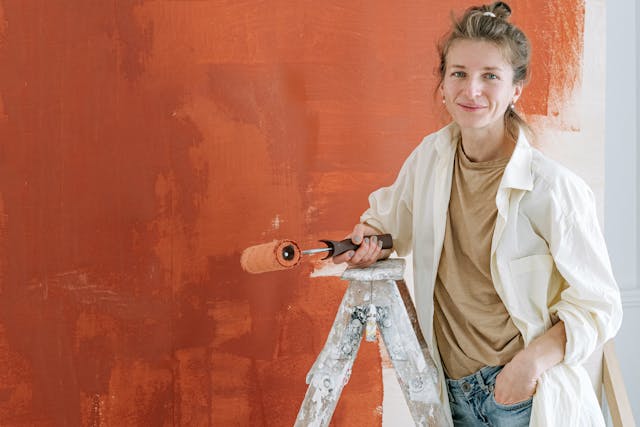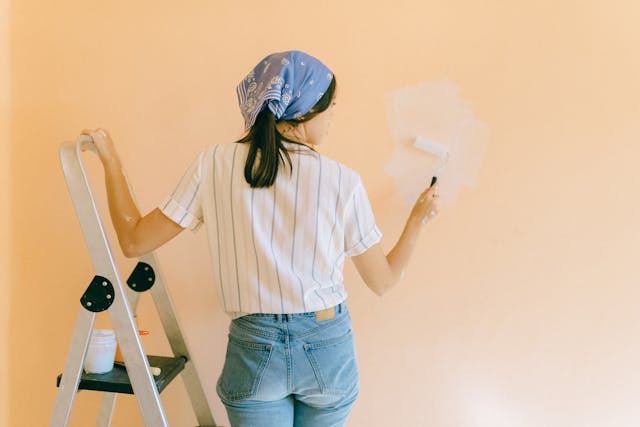Color has always shaped the spaces we live and work in, but the way it’s chosen, applied, and experienced is evolving faster than ever. Technology is no longer just an accessory in the painting industry—it’s becoming the core driver of innovation. From AI-assisted color selection to advanced application tools and sustainable paint formulations, technology is redefining how professionals approach both residential and commercial painting projects.
Digital Color Visualization and AI Matching
In the past, choosing a color meant flipping through physical swatches and guessing how it would look on a wall. Today, digital visualization tools are transforming that experience. Using augmented reality and AI-powered apps, homeowners and business owners can see how a color will appear in their actual space before a single brushstroke is made. The lighting, texture, and even décor are factored in to create a realistic preview that minimizes error and regret.
Artificial intelligence can now analyze room dimensions, natural light exposure, and existing furnishings to recommend shades that harmonize perfectly with the environment. This level of customization not only saves time but also elevates client satisfaction. It bridges the gap between imagination and reality, making design decisions more data-driven and less dependent on instinct alone.
Smart Devices and Connected Paint Systems
Technology is also changing how paint is mixed and applied. Smart color-matching devices now allow painters to scan a surface and instantly identify the exact shade or find the closest match in a digital palette. These handheld tools ensure consistency across multiple areas, which is particularly valuable in large commercial projects where uniformity is crucial.
Beyond color matching, connected paint systems can adjust viscosity, monitor humidity, and regulate spray pressure automatically. These innovations reduce material waste and improve finish quality. In the near future, we may see “smart sprayers” that communicate with digital design files, applying paint with precision based on pre-programmed patterns. This level of automation could redefine productivity for painting professionals.
Robotics and Automation in Painting
Automation is no longer reserved for manufacturing—painting robots are now entering both residential and commercial markets. These machines can handle repetitive tasks like priming, base coating, or ceiling work with incredible consistency. By integrating sensors and computer vision, they can navigate complex spaces, detect surface irregularities, and apply paint evenly with minimal overspray.
For commercial contractors, robotic systems offer major advantages in speed and safety. They can reach high or hazardous areas without scaffolding and maintain continuous operation with minimal downtime. While these technologies are still emerging, they represent a significant step toward combining craftsmanship with efficiency, allowing human painters to focus on artistry and detail work.
Sustainable Paint Innovations
Sustainability is becoming a cornerstone of modern painting technology. Advances in chemistry are producing eco-friendly paints that minimize volatile organic compounds (VOCs), reduce odor, and improve air quality. Many formulations now include bio-based materials or self-cleaning properties that extend the life of a finish.
Digital tools also play a role in sustainability. By calculating exact material requirements, AI systems can reduce excess paint usage and waste. Smart inventory management and digital ordering platforms help contractors minimize transportation emissions and overstocking. In the future, sustainability won’t be a separate consideration—it will be built into every stage of the painting process, from design to disposal.
Color Psychology and Data Science
Understanding how color influences mood and productivity has always been part of design, but technology now allows these insights to be quantified. Through data analytics and user feedback, companies are studying how different color schemes affect performance, relaxation, and focus in specific environments.

For example, AI algorithms can analyze thousands of design outcomes to predict which colors will enhance concentration in offices or encourage calmness in healthcare settings. This evidence-based approach is redefining color psychology as a measurable science rather than an abstract art. Painters and designers can now select palettes that are not just aesthetically pleasing but also functionally optimized for human behavior.
The Role of Virtual and Remote Collaboration
Virtual reality and digital collaboration tools are reshaping how painting projects are planned and managed. Designers, contractors, and clients can now meet in a shared virtual environment to preview color combinations and surface finishes before work begins. Changes can be made instantly, saving both time and cost.
In large commercial developments, remote project management platforms enable real-time updates on progress, scheduling, and quality control. Painters can receive digital blueprints directly to their smart devices, ensuring precise execution on-site. This integration of design, communication, and delivery marks a new era of efficiency and transparency in the painting industry.
Enhanced Surface Technology and Smart Coatings
The paint itself is getting smarter. Advances in nanotechnology are leading to coatings that can self-heal minor scratches, resist stains, and even purify the air. Some modern formulations include thermochromic or photochromic properties, allowing color to shift based on temperature or light exposure.
In commercial settings, smart coatings are being used for energy efficiency—reflective paints that reduce heat absorption can lower cooling costs significantly. In residential applications, antimicrobial finishes are gaining popularity for kitchens and bathrooms. The fusion of chemistry and digital monitoring means paint will soon become an active participant in maintaining building health, not just an aesthetic layer.
The Impact of 3D Printing and Custom Finishes
3D printing is beginning to influence painting through the creation of custom surface textures and decorative elements. Walls can now be designed with intricate reliefs that combine paint with printed detail for a multidimensional finish. This opens new creative possibilities for both home and commercial spaces.
Moreover, precision printing technology allows for digital murals and branding graphics that can be applied with perfect alignment and color consistency. Businesses can incorporate their identity directly into interior design, while homeowners can create personalized art that integrates seamlessly with architecture. This blending of design and digital craftsmanship represents the next frontier of decorative painting.
Data-Driven Maintenance and Predictive Care
In both residential and commercial settings, maintenance can now be managed through predictive analytics. Smart sensors embedded in surfaces or environmental systems can detect wear, fading, or moisture before visible damage occurs. These insights allow for proactive repainting and reduce long-term repair costs.
Contractors and facility managers can receive automatic alerts and performance reports, creating a continuous feedback loop between paint application and upkeep. Predictive care extends the lifespan of finishes, saves resources, and ensures properties remain visually appealing and structurally protected year-round.
The Future of Painting Professionals
As technology takes on more technical tasks, painters will increasingly become consultants, designers, and creative problem-solvers. Their value will lie not only in manual skill but in understanding how to use digital tools effectively. The modern painter will need literacy in software, data interpretation, and sustainability principles.
This evolution will also elevate the reputation of the profession. Painting will be viewed not as simple labor but as a technology-driven discipline that blends science, art, and innovation. The future of painting professionals will depend on adaptability—those who embrace emerging tools will lead an industry that’s more precise, efficient, and creative than ever before.
Conclusion: Where Innovation Meets Expression
Technology is redefining painting from every angle—how colors are chosen, how they are applied, and how they interact with the environment over time. As digital systems, robotics, and smart materials converge, painting is becoming both a science and an art of precision. The result is an industry poised for transformation, where imagination meets innovation.
The future of color will be more intelligent, sustainable, and expressive than anything seen before. Whether it’s a family home or a corporate high-rise, technology is turning every surface into a canvas of possibility—one where creativity and computation work hand in hand to redefine the power of paint.
